Complaints that the overwhelming majority of science and engineering graduates churned out by India’s 352 universities and 18,000 colleges are nowhere near industry ready are rising to a crescendo as there’s growing awareness that the technical education being dispensed by them is way below par. Hemalatha Raghupathi reports from Chennai
 It’s a quietly building crisis which could torpedo the country’s spectacular 9 percent per year rate of economic growth and put paid to India’s industrial superpower aspirations. Even as ill-informed reports in the western media herald that India possesses the world’s second largest pool of technical and scientific manpower, India Inc, confronted with an unprecedented shortage of skilled professionals and technicians, is unimpressed. Complaints that the overwhelming majority of the 1.2 million science and engineering graduates churned out by India’s 352 universities and 18,000 colleges are nowhere near industry ready are rising to a crescendo as there’s growing awareness that the technical education being dispensed by them is way below par, if not obsolete.
It’s a quietly building crisis which could torpedo the country’s spectacular 9 percent per year rate of economic growth and put paid to India’s industrial superpower aspirations. Even as ill-informed reports in the western media herald that India possesses the world’s second largest pool of technical and scientific manpower, India Inc, confronted with an unprecedented shortage of skilled professionals and technicians, is unimpressed. Complaints that the overwhelming majority of the 1.2 million science and engineering graduates churned out by India’s 352 universities and 18,000 colleges are nowhere near industry ready are rising to a crescendo as there’s growing awareness that the technical education being dispensed by them is way below par, if not obsolete.
The growing panic in India Inc and belatedly in the ivory towers of the Union government (the Union budget 2008-09 announced a slew of projects to expand and upgrade science and technology education) has been fuelled by a 2005 study conducted jointly by the Delhi-based NASSCOM (National Association of Software and Services Companies) and the NewYork-based McKinsey Global Institute, which indicates that a mere 25 percent of the 495,000 graduates churned out annually by India’s 2,240 engineering colleges are industry ready. The study also predicts a massive demand-supply mismatch with the demand for employable information technology (IT) professionals (500,000 in 2008) outstripping the supply of 360,000 IT industry-suited graduates produced by institutes of professional education. This demand-supply gap is expected to widen further in the next two years with a predicted shortfall of 500,000 IT professionals by 2010. Against this, direct employment in the Indian IT-BPO sector is expected to rise from 1.6 million in 2007 to nearly 2 million this year and to 3.2 million by 2010.
“The NASSCOM-McKinsey study found that the three major constraints to the employability of Indian engineering graduates are lack of English language communication skills; inadequate domain knowledge, and technical skills especially among graduates of the vast majority of second and third rung engineering colleges which are burdened with obsolete curriculums and poor quality faculty,” says Kiran Karnik, the Delhi-based former president of NASSCOM, the consortium which serves as the lobby of the Indian software and BPO industries.
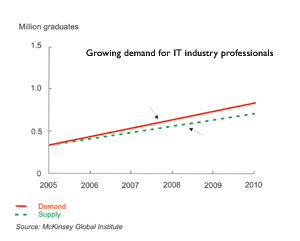 A looming shortage of adequately trained professionals is not confined to the IT-BPO sectors but is also causing sleepless nights for managers in the infrastructure, manufacturing, retail and services industries as well. The Indian Labour Report (ILR) 2007, commis-sioned and released by Bangalore-based human resources and staffing agency, Team Lease Services, is even more scathing about the output of the national education system.
A looming shortage of adequately trained professionals is not confined to the IT-BPO sectors but is also causing sleepless nights for managers in the infrastructure, manufacturing, retail and services industries as well. The Indian Labour Report (ILR) 2007, commis-sioned and released by Bangalore-based human resources and staffing agency, Team Lease Services, is even more scathing about the output of the national education system.
According to ILR 2007, 82.5 million of India’s youth labour force of 145 million is unemployable, with 5.3 million requiring “last mile repair” (six months), 21.9 million requiring “interventional repair” (six months to one year), and a massive 55.4 million requiring “structural repair” (one-two years). “Repairing this skill deficit needs Rs.490,000 crore over two years. Current budgets cover only 25 percent of this,” says the report.
Although of the 82.5 million suffering some degree of skill deprivation, only 11 million are unemployed, the poor quality of skills of the employed is reflected in low incomes rather than unemployment with 58 percent of employed graduates taking home less than Rs.75,000 per year. According to ILR 2007 the root cause of the low incomes of India’s 71.4 million under-employed is “demand-supply mismatch”. While 90 percent of jobs require vocational skills, 90 percent of India’s school and college education is theoretical and “bookish”.
At the centre of this ballooning crisis is a higher technical education system collapsing under the weight of obsolete syllabuses, under-qualified faculty, neglect of soft skills education and lack of practical on-the-job training. Barring the seven IITs, 20 NITs and a handful of top-rung professional colleges, the majority of India’s 2,240 engineering and technical institutes deliver substandard education.
For instance a majority of the 1,793 private engineering colleges that have mushroomed in the past decade in Tamil Nadu, Karnataka, Andhra Pradesh, Maharashtra and Kerala, which together produce 69 percent of the country’s 495,000 engineering graduates per year, are experiencing severe faculty shortages with few Ph Ds engaged in teaching. Moreover their curriculums are out of step with industry requirements and lecture-based content delivery to students with inadequate grasp of English is a glaring lacuna compounded by neglect of hands-on training. Most private engineering colleges also suffer glaring infrastructure deficiencies including lack of libraries, computers and laboratories.
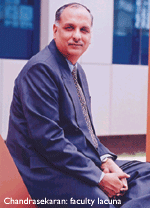 “While a small number of established institutions such as IITs, NITs, and others continue to deliver their brand promise, the several hundred new engineering colleges which have mushroomed during the past decade have difficulty in attracting qualified faculty and/or retaining them. Neither do they attract the best students. It is the growing number of students graduating from these poorly managed colleges who experience unemployment. In addition to domain expertise and practical training, fresh engineering graduates also require training in soft and behavioural skills,” says R. Chandrasekaran, managing director of the Chennai-based Cognizant Technology Solutions (sales revenue: Rs.8,923 crore), which campus recruited over 16,000 engineering graduates last year.
“While a small number of established institutions such as IITs, NITs, and others continue to deliver their brand promise, the several hundred new engineering colleges which have mushroomed during the past decade have difficulty in attracting qualified faculty and/or retaining them. Neither do they attract the best students. It is the growing number of students graduating from these poorly managed colleges who experience unemployment. In addition to domain expertise and practical training, fresh engineering graduates also require training in soft and behavioural skills,” says R. Chandrasekaran, managing director of the Chennai-based Cognizant Technology Solutions (sales revenue: Rs.8,923 crore), which campus recruited over 16,000 engineering graduates last year.
With the economy maintaining its 8-9 percent per year growth momentum and the IT-BPO industry struggling to maintain its fast and furious offshore business growth rate of 25 percent per year, the shortage of adequately prepared engineering graduates is badly hurting. Little wonder IT industry leaders are crying themselves hoarse in every seminar and conference about the poor quality of engineering graduates which is driving up wages and threatening the cost-competitiveness of India’s high potential IT/ITES and BPO industries.
But although the writing’s been on the wall for a long time and repeatedly proclaimed in EducationWorld for the past eight years, it’s taken the over-hyped leaders of the IT industry a long while to decipher it and act rather than complain. Recently and rather belatedly, NASSCOM has launched a series of initiatives to upgrade the physical and intellectual infrastructure of engineering colleges to enable them to improve the quality of their output, i.e. graduates.
The association’s IT Workforce Development (ITWD) programme initiated in 2004, incorporates a slew of industry-academia interfaces which include workshops and conferences, faculty training programmes, and mentorship initiatives. NASSCOM is also working with the Union ministry of human resource development (HRD) to promote five new Indian Institutes of Information Technology (IIITs) based on the public-private partnership model by end 2008 and gradually expand it to 20 IIITs over the next few years. Moreover, to equip young engineering graduates with industry-ready skills, it initiated a ‘Finishing Schools for Engineering Students’ programme, also in partnership with the HRD ministry.
The first of the eight-week finishing schools programme was piloted in May-June last year in eight selected institutions (IIT Roorkee and seven National Institutes of Technology in Calicut, Durgapur, Kurushetra, Jaipur, Surathkal, Trichy and Warangal) for 100 BE and B.Tech graduates of second and third rung colleges who despite possessing technical knowledge were not selected during campus recruitment. Designed to reinforce basic technical skills, impart industry specific knowledge and develop soft skills, the finishing school course is being delivered jointly by faculty of the eight short-listed institutions and guest faculty from the IT and ITES industry.
Against this backdrop of general acceptance that the education being dispensed by the great majority of the country’s 2,240 engineering colleges is substandard as a result of which workplace productivity of Indian technicians and engineers is poor, it’s hardly surprising that Indian industry incurs perhaps the highest in-house personnel training costs worldwide. To make up for teaching-learning shortfalls at collegiate and university levels most corporates invest heavily in in-house education programmes to bring industry-unready graduates up to speed. Indeed IT industry heavyweights such as Infosys Technologies, Tata Consultancy Services (TCS), and Wipro run full-fledged collegiate-style training institutions to make good the glaring deficiencies of India’s moribund engineering colleges (see box p.69). According to company sources, Infosys reportedly spends Rs.500,000 per fresher recruited to get him/her industry ready. This isn’t a small sum. It’s more than the aggregated tuition fee of a four-year study programme in any of India’s highly rated Indian Institutes of Technology (IITs) and/or a top-rung private engineering college.
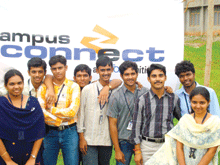 Thus encumbered with the world’s highest personnel training costs and abysmal organisational productivity, Indian companies have belatedly started seriously engaging with the deep rooted — mainly government created — problems of Indian academia. For instance Infosys Technologies launched a nationwide Campus Connect programme in May 2004 to help engineering colleges develop and nurture high-quality talent for the IT industry. Operational in 380 engineering colleges across eight cities, under the Rs.10 crore per year Campus Connect initiative, Infosys conducts seminars and faculty training workshops to share best industry practices, helps upgrade college curriculums to meet with industry requirements, and offers students access to the company’s in-house courseware over the internet.
Thus encumbered with the world’s highest personnel training costs and abysmal organisational productivity, Indian companies have belatedly started seriously engaging with the deep rooted — mainly government created — problems of Indian academia. For instance Infosys Technologies launched a nationwide Campus Connect programme in May 2004 to help engineering colleges develop and nurture high-quality talent for the IT industry. Operational in 380 engineering colleges across eight cities, under the Rs.10 crore per year Campus Connect initiative, Infosys conducts seminars and faculty training workshops to share best industry practices, helps upgrade college curriculums to meet with industry requirements, and offers students access to the company’s in-house courseware over the internet.
In addition, an Infosys research and development team has designed a unique seven-month Special Training Programme (STP) to upgrade the communications and technical skills of unemployed engineering graduates from disadvantaged socio-economic back-grounds. Currently STP is being implemented by Infosys in partnership with the Andhra Pradesh state government, other corporate partners and educational institutions, and expects to upgrade skills of 2,500 students by December 2009.
“All IT companies have to invest heavily in training fresh engineering graduates to make them job ready. Our response has been to cast our net wider by recruiting science and business management graduates and also hiring graduates of foreign universities. However, since the magnitude of the problem is huge, we believe it makes good sense to prompt curricular reforms at the university level, provide research grants to educational institutions and offer scholarships. Industry must actively collaborate with engineering colleges to nurture high potential talent. Our Campus Connect programme is a step in this direction,” says Nandita Gurjar, the Bangalore-based vice-president, human resources at Infosys.
Similarly TCS, India’s numero uno IT software development company (annual sales revenue: Rs.18,253 crore) with 89,500 employees across 47 countries around the world, has also initiated several industry-academia partnerships to raise standards in engineering and technical education institutions. The company’s Academic Interface Programme (AIP) conducts student and faculty development workshops and offers ‘sabbaticals’ at TCS for academics, sponsors awards for merit students and offers workplace internships to promising students. TCS also collaborates with select universities and engineering colleges to design software engineering study programmes aligned to the specific needs of the IT industry. Moreover its seven-month intensive programme ‘Ignite’ is designed to transform science graduates into software professionals. In addition an annual meet with heads of engineering colleges (‘Sangam’) serves as a forum to share and understand viewpoints to create mutually beneficial sourcing systems.
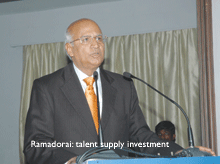 In 2007, AIP reached 396 engineering and technical education colleges across tier I, II and III cities in India, with the target set for 434 institutes this year. “Nearly 60 percent of TCS recruits every year are freshers. As the largest employer in the IT industry, we invest significant resources and time to nurture and develop talent for the future. We believe long-term relationships between academia and the industry will enhance employability of graduates and build a steady talent supply chain for industry,” says S. Ramadorai, the Mumbai-based CEO and managing director of TCS.
In 2007, AIP reached 396 engineering and technical education colleges across tier I, II and III cities in India, with the target set for 434 institutes this year. “Nearly 60 percent of TCS recruits every year are freshers. As the largest employer in the IT industry, we invest significant resources and time to nurture and develop talent for the future. We believe long-term relationships between academia and the industry will enhance employability of graduates and build a steady talent supply chain for industry,” says S. Ramadorai, the Mumbai-based CEO and managing director of TCS.
Also on the tcs drawing board is a chain of finishing schools to be established in collabo-ration with several state governments, with the company providing faculty support and content and the state government contributing infrastructure. As a first step TCS has signed up with Webel (the nodal agency of the West Bengal government for developing the IT and ITES industries in the state) to establish the Webel Finishing School, Kolkata. A six-month study programme designed by TCS tops up the technology and programming knowhow of engineering graduates while enhancing their English language and other soft skills.
Nor is intensified industry-academia cooperation designed to improve the industry readiness of engineering graduates the sole preserve of IT companies. In March the Chennai-based TVS Group of 29 companies, India’s primary manufacturer of automobile components, announced the launch of a finishing school for engineering grads in collaboration with IIT-Madras. Established under the auspices of Lakshmi Vidya Sangham (a registered society of the TVS Group which runs five schools in Madurai with an aggregate student enrollment of 10,000), the Madurai-based finishing school will admit its first batch of 30 engineering graduates in July. While engineers of the TVS group will offer hands-on practical training, IIT-M faculty will deliver classroom teaching (tuition fee: Rs.70,000). Students who successfully complete the one-year advanced certificate course in engineering design and analysis will be employed by the TVS group.
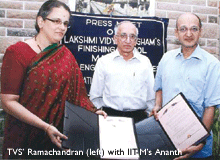 “Engineering graduates tend to lack industry-relevant skills because college curriculums are totally out of sync with industry needs. Practical exposure to advanced engineering software and modern machinery is non-existent and faculty in most colleges is ignorant of industry requirements since their own education tends to be limited. The objective of our finishing school is to help students apply their learning on shopfloors to qualify to meet the current and future expectations of industry,” says Shobhana Ramachandran, managing director of Lakshmi Vidya Sangham and chairperson of all TVS schools.
“Engineering graduates tend to lack industry-relevant skills because college curriculums are totally out of sync with industry needs. Practical exposure to advanced engineering software and modern machinery is non-existent and faculty in most colleges is ignorant of industry requirements since their own education tends to be limited. The objective of our finishing school is to help students apply their learning on shopfloors to qualify to meet the current and future expectations of industry,” says Shobhana Ramachandran, managing director of Lakshmi Vidya Sangham and chairperson of all TVS schools.
Yet it’s an ill wind that blows nobody good. The inability of India’s engineering colleges to produce industry-ready graduates has spawned a new genre of ‘finishing schools’ mushrooming across the country. Such as 3 Edge Solutions promoted by mechanical engineer Prasad Kolisetty in December 2006 in partnership with Cognizant Technology Solutions. This finishing school which admitted its first batch of 35 students in 2006 for its three-month programmes has trained 350 students to date and has successfully placed 95 percent of them in software companies. Inspired by its success in Chennai, 3 Edge Solutions has promoted two more finishing schools in Hyderabad and Chandigarh.
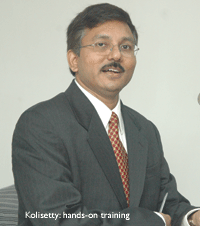 “With industry profit margins under pressure in an inflationary environment and corporates increasingly weighing high training costs, finishing schools for engineering graduates have become a necessity. We cater to students from tier II and III colleges who are technically proficient but lack communication and workplace skills. These students are given hands-on training in advanced technology and simultaneously provided soft skills training. Moreover we have begun offering a six-month industry preparatory programme on the internet enabling engineering colleges to integrate it into the curriculum of the final year engineering course,” says Kolisettty.
“With industry profit margins under pressure in an inflationary environment and corporates increasingly weighing high training costs, finishing schools for engineering graduates have become a necessity. We cater to students from tier II and III colleges who are technically proficient but lack communication and workplace skills. These students are given hands-on training in advanced technology and simultaneously provided soft skills training. Moreover we have begun offering a six-month industry preparatory programme on the internet enabling engineering colleges to integrate it into the curriculum of the final year engineering course,” says Kolisettty.
While finishing schools for engineering graduates are doing their bit to transform raw graduates of upcountry engineering colleges into job ready professionals, quite clearly a more intelligent response to the grave challenge of India’s snowballing technical skills shortage is required. For one, there’s an urgent need for industry — particularly IT corporates which have enjoyed income tax free status for over a decade despite super profits — to take the initiative to promote model engineering colleges/universities and vocational institutes which would upgrade and benchmark engineering and technical education.
Simultaneously there’s an urgent need for India’s 2,240 engineering colleges and technical institutes to grasp the nettles of serious curriculum reform and faculty development initiatives. “The acute shortage of faculty is a bigger crisis than student unemployability. The abysmal pay scales of engineering colleges pale in comparison to industry pay packets with the result that the best and brightest are lost to academia,” rues M.S. Ananth, director, IIT-Madras, who says that even reputed IITs have begun experiencing the problem of graduate unemployability.
“IIT graduates are grabbed by industry because they are extremely bright students, yet 5 percent of them don’t possess adequate soft skills and suffer rejection problems. The IT industry constantly laments about students lacking soft skills but that’s not the province of engineering colleges which have to impart technical skills and domain knowledge to students. Industry leaders must acknowledge the fundamental difference between educational institutions and industry, and should not expect fresh graduates to possess well developed skills ab initio. IT companies need to budget time and money to train fresh graduates in-house for six months instead of blaming industry unreadiness on engineering institutions,” says Ananth.
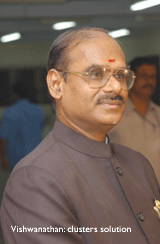 Dr. D. Vishwanathan, vice-chancellor of the premier Anna University in Chennai, concurs. “The IT industry is dynamic and software languages introduced two years ago can be obsolete now. Engineering and IT companies keep updating their technologies, switching to newer processes rapidly, thus making it very difficult for universities and colleges to keep up. Therefore one solution is for engineering colleges to form clusters and start finishing schools in collaboration with private industry so that students can update their skills. Simultaneously faculty can help students master English and develop communication skills. Moreover universities and colleges need to be given greater autonomy and academic freedom to innovate their curriculums,” says Vishwanathan.
Dr. D. Vishwanathan, vice-chancellor of the premier Anna University in Chennai, concurs. “The IT industry is dynamic and software languages introduced two years ago can be obsolete now. Engineering and IT companies keep updating their technologies, switching to newer processes rapidly, thus making it very difficult for universities and colleges to keep up. Therefore one solution is for engineering colleges to form clusters and start finishing schools in collaboration with private industry so that students can update their skills. Simultaneously faculty can help students master English and develop communication skills. Moreover universities and colleges need to be given greater autonomy and academic freedom to innovate their curriculums,” says Vishwanathan.
But Kiran Karnik, former president of NASSCOM is not inclined to beat around the bush and squarely blames Central and state governments and the Delhi-based All India Council for Technical Education (AICTE) in particular for interference and over-regulating engineering education. “AICTE prescribes tall criteria for physical infrastructure, but completely overlooks quality of faculty, pedagogy and other factors which are as critical. There’s no getting around the need to attract qualified and meritorious faculty by offering market-driven pay scales, and AICTE permitting companies to enter professional education without restriction,” says Karnik.
 Although AICTE has belatedly initiated a programme to offer ‘summer school’ induction training, short term refresher courses and advanced technology and leadership to 10,000 faculty of engineering/technical colleges in premier institutions such as Indian Institute of Science, IITs, NITs, IITs etc (advertised in the Times of India, May 25), there’s an emerging consensus within educationists and industry spokespersons that any reform of India’s technical education system must begin with AICTE. Its regulatory stranglehold over professional (engine-ering, business management, pharmacy, hotel management etc) education has dumbed down engineering and technical education. They charge it with being corrupt and too liberally licensing colleges without checking quality of faculty and curriculums offered. Unsurprisingly calls for scrapping AICTE are getting louder. In a letter dated October 15, 2007, even the National Knowledge Commission (NKC) chaired by telecom multi-millionaire Sam Pitroda has recommended the scrapping of the council and replacing it with an IRAHE (Independent Regulatory Authority for Higher Education).
Although AICTE has belatedly initiated a programme to offer ‘summer school’ induction training, short term refresher courses and advanced technology and leadership to 10,000 faculty of engineering/technical colleges in premier institutions such as Indian Institute of Science, IITs, NITs, IITs etc (advertised in the Times of India, May 25), there’s an emerging consensus within educationists and industry spokespersons that any reform of India’s technical education system must begin with AICTE. Its regulatory stranglehold over professional (engine-ering, business management, pharmacy, hotel management etc) education has dumbed down engineering and technical education. They charge it with being corrupt and too liberally licensing colleges without checking quality of faculty and curriculums offered. Unsurprisingly calls for scrapping AICTE are getting louder. In a letter dated October 15, 2007, even the National Knowledge Commission (NKC) chaired by telecom multi-millionaire Sam Pitroda has recommended the scrapping of the council and replacing it with an IRAHE (Independent Regulatory Authority for Higher Education).
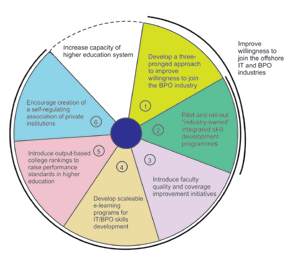 More recently in a letter dated May 6 to the prime minister, Pitroda recomm-ended the adoption of lesser-known engineering institutions by IITs to help them raise standards. Moreover he mooted the public-private partnership model to correct glaring regional imbalances in the availability of engineering education and advocated mobility between science and engineering streams.
More recently in a letter dated May 6 to the prime minister, Pitroda recomm-ended the adoption of lesser-known engineering institutions by IITs to help them raise standards. Moreover he mooted the public-private partnership model to correct glaring regional imbalances in the availability of engineering education and advocated mobility between science and engineering streams.
Quite clearly a radical overhaul of the technical education system and training regime is urgently required to meet the rising demand of industry for adequately prepared engineers and technical professionals. But the response to this unprecedented challenge can’t be left to government educrats or private sector promoters of engineering colleges with dollar signs in their eyes. Indian industry needs to actively engage with engineering and technical education to design new syllabuses, innovate new curriculums and raise teaching standards and learning outcomes across the board. After all it has the most to lose.
With Autar Nehru (Delhi); Vidya Sundaresan (Mumbai) & Mekhala Roy (Bangalore)